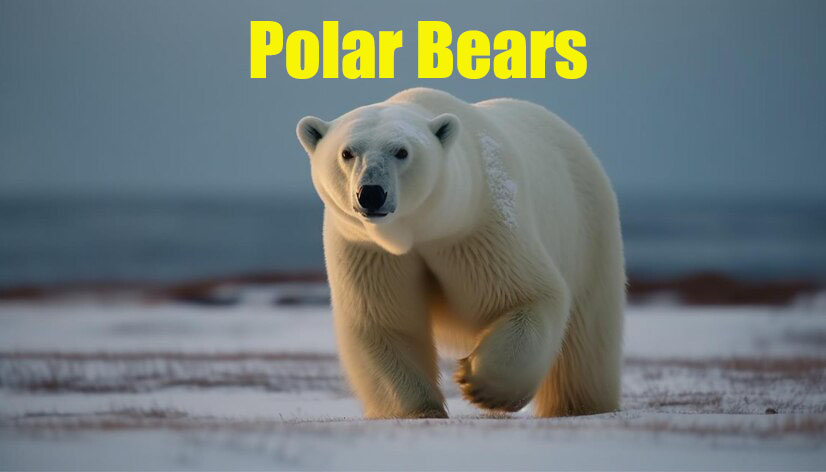Polar bears, the largest land carnivores on Earth, are iconic symbols of the Arctic. These majestic creatures, scientifically known as Ursus maritimus, are uniquely adapted to survive in the harsh and unforgiving conditions of the Arctic Circle. Let’s delve into the fascinating world of polar bears, exploring their habitat, behavior, diet, conservation status, and the challenges they face in a changing environment.
Habitat and Range
Polar bears inhabit the icy regions of the Arctic, including Alaska, Canada, Greenland, Norway, and Russia. They are most commonly found along the edges of sea ice, where they hunt for seals, their primary prey. These bears are superbly adapted to the Arctic environment, with thick fur coats and a layer of blubber to insulate them from the cold.
Physical Characteristics
One of the most distinctive features of polar bears is their thick, white fur, which helps them blend into their snowy surroundings. Beneath their fur, polar bears have black skin, which absorbs heat from the sun to keep them warm. They also have large, powerful paws equipped with sharp claws for gripping the ice and catching prey.
Behavior and Social Structure
Polar bears are solitary animals for most of the year, with the exception of mating and maternal care. They are excellent swimmers and can travel long distances in search of food. During the summer months, when sea ice melts, polar bears may come ashore and wait for the ice to reform.
Diet and Hunting
Seals are the primary prey of polar bears, particularly ringed and bearded seals. Polar bears use their keen sense of smell to detect seals’ breathing holes in the ice and patiently wait for them to surface. Once a seal is spotted, polar bears use stealth and ambush tactics to catch their prey, often breaking through the ice to reach them.
Conservation Status
Polar bears are classified as vulnerable by the International Union for Conservation of Nature (IUCN) due to the significant threat posed by climate change. The loss of sea ice habitat, which polar bears rely on for hunting and breeding, is the biggest threat to their survival. Other factors, such as pollution, oil and gas development, and human-bear conflicts, also contribute to their declining populations.
Conservation Efforts
Efforts to conserve polar bears include research to better understand their behavior and habitat use, as well as initiatives to reduce greenhouse gas emissions and mitigate climate change. Additionally, regulations on hunting and trade help protect polar bear populations from overexploitation.
Challenges Ahead
Despite conservation efforts, polarbears face an uncertain future as climate change continues to rapidly alter their Arctic habitat. Rising temperatures lead to shrinking sea ice, which reduces hunting opportunities and forces bears to travel longer distances in search of food. As a result, polarbears are increasingly coming into contact with human settlements, leading to conflicts and safety concerns for both bears and humans.
Conclusion
Polar bears are magnificent creatures uniquely adapted to thrive in one of the harshest environments on Earth. However, their survival is threatened by the rapidly changing climate and human activities. As stewards of our planet, it is crucial that we take action to protect polar bears and their fragile Arctic ecosystem before it’s too late.
FAQs
- Are polar bears endangered?
Yes, polarbears are classified as vulnerable by the International Union for Conservation of Nature (IUCN) due to the significant threat posed by climate change and habitat loss.
- What do polarbears eat?
Polarbears primarily feed on seals, particularly ringed and bearded seals. They rely on sea ice as a platform for hunting seals, their main source of food.
- How do polarbears survive in the Arctic?
Polarbears are adapted to survive in the harsh Arctic environment with their thick fur coats, layer of blubber for insulation, and keen hunting skills. They are excellent swimmers and can travel long distances in search of food.
- Are polarbears dangerous to humans?
While polarbears are generally not aggressive towards humans, they can be dangerous if provoked or if they perceive humans as a threat. Encounters between polarbears and humans should be avoided, and proper precautions should be taken when visiting polarbear habitat.
- How can we help polarbears?
There are several ways to help polarbears, including reducing greenhouse gas emissions to mitigate climate change, supporting conservation efforts and research, minimizing human-bear conflicts by properly storing food and waste in polarbear habitat, and advocating for policies that protect their Arctic habitat.











